Complete Solutions to SECTION - B Numericals (Numerical From Textual Exercise) of chapter WORK, ENERGY AND POWER of Class 11 book with complete answers and questions
| Class 11 | PHYSICS |
| Chapter | WORK, ENERGY AND POWER |
| KUMAR PRAKASHAN | SECTION - B Numericals (Numerical From Textual Exercise) |
| Number Of Questions | 42 |
| Academic Year | 2023-24 |
The sign of work done by a force on a body is important to understand .State carefully if the following quantities are positive or negative :
(a) work done by a man in lifting a bucket out of a well by means of a rope tied to the bucket .
(b) work done by gravitational force in the above case ,
(c ) work done by friction on a body siding down an inclined plane ,
(d ) workdone by an applied force on a body moving on a rough horizontal plane woth uniform velocity .
(d) work done by the resistive force of air on a vibrating pendulum in bringing it to rest .
View SolutionA body of mass 2 kg initially kg intially at rest moves under the action of an applied horizontal force of 7 N on a table with coefficient of kinetic friction = `0.1 ` Compute the
(a) work done by the applied force in 10 s.
(b) work done by friction in 10 s .
work done by the net force on the body in 10 s.
(d) Change in kinetic energy of the body in 10 s and interpret your details .
View SolutionGiven in figure are examples of some potential energy functions in one dimension. The total energy of the aprticle is indicated by a cross on the ordinate axis . In each case , specify the regions ,if any , in which the particle cannot be found for the given energy .Also , indicate the minimum total energy the particle must have in each case . Think of simple physical contexts for which these potential energy shapes are relvant .
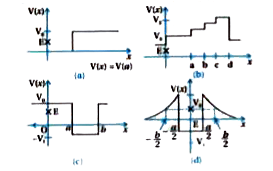
View SolutionThe potential energy function for a particle executing linear simple harmonic motion is given by `V(x) = (kx^(2))/2 ` where k is the force constant of the oscillator . For `k = 0.5 "Nm"^(-1)` , the graph of V(x) versus x is shown in figure . Show that a particle of total energy 1 J movng under this potential must 'turn back ' when it reaches `x = pm 2 m ` .

View SolutionThe spring of a rocket in flight burns up due to friction .At whose expense is the heat energy required for burning obtained ? The rocket or the atmosphere ?
View SolutionComets move around the sun in highly elliptical orbits . The gravitational force on the comet due to the sun is not normal to the comet's velocity in general. yet the work done by the gravitational force over energy complete orbit of the comet is zero . Why ?
View SolutionAn artificial satellite orbiting the earth in very thin atmosphere loses its energy gradually due to dissipation against atmospheric resistance , however small .Why then does its speed increase progressively as it comes closer and closer the earth ?
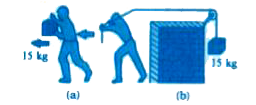
View SolutionIn figure (i) the man walks 2 m carrying a mass of 15 kg on his hands .In figure (ii) , he walks the same distance pulling the rope behind him . The rope goes over a pulley , and a mass of 15 kg hangs at its other end . In which case is the work done greater ?
View SolutionWhen a conservative force does positive work on a body , the potential energy of the body increases /decreases/ remains unaltered .
View SolutionWork done by a body against friction always results in a loss of its kinetic/potential energy .
View SolutionThe rate of change of total momentum of a many -particle system is proportional to the external force/sum of the internal forces on the system .
View SolutionIn an inelastic collision of two bodies, the quantities which do not change after the collision are the total kinetic energy/total linear momentum/total energy of the system of two bodies.
View SolutionIn an elastic collision of two bodies , the momentum and energy of each body is conserved .
View SolutionTotal energy of a system is always conserved , no matter what internal and external forces on the body are present .
View SolutionWork done in the motion of a body over a closed loop is zero for every force in nature .
View SolutionIn an elastic collision , the final kinetic energy is always less than the initial kinetic energy of the system .
View SolutionIn an elastic collision of two bodies , the momentum and energy of each body is conserved .
View SolutionExplain the total linear momentum is conserved in an elastic collision and also explain the inelastic collision and completely elastic collision .
View SolutionPractically, if 10kJ of energy is supplied to a device, how much energy will the device give back?
View SolutionIf the potential energy of two billiard balls depends only on the separation distance between their centres , is the collision elastic or inelastic ? ( Note , we are talking here of potential energy corresponding to the force during collision , not gravitational potential energy ).
View SolutionA body is initially at rest . It undergoes one - dimensional motion with constant acceleration .The power delivered to it at time t is proportional to
View SolutionA body is moving indirectionally under the influence of a source of constant power . Its displacement in time t is proportional to
View SolutionA body constrained to move along the z -axis of a coordinate system is subject to a constant force F given by `vec(F) =(-hat(i)+2hat(j)+3hat(k))N` where `hat(i),hat(j),hat(k)` are unit vectors along the x, y and z-axis of the system respectively . What is the work done by this force in moving the body a distance of 4 m along the z- axis?
View SolutionAn electron and a proton are detected in a cosmic ray experiment , the first with kinetic energy 10 keV and the second with 100 keV.Which is faster , the electron or the proton ? Obtain the ratio of their speeds . (electron mass `= 9.11 xx10^(-31)` kg , proton mass = `1.67 xx10^(-27)kg , 1 eV = 1.60 xx10^(-19)`J)
View SolutionA rain drop of radius 2 mm falls from a height of 500 m above the ground .It falls with decreasing acceleration (due to viscous resistance of the air) until at half its original height , it attains its maximum (terminal) speed, and moves with uniform speed thereafter .What is the work done by the gravitational force on the drop in the first and second half of its journey ?What is the work done by the resistive force in the entire journey if its speed on reaching the ground is `1 ms^(-1)` ?
View SolutionA molecule in a gas container hits a horizontal wall with speed `200 ms^(-1) and " angle " 30^(@)` with the normal , and rebounds with the same speed . Is momentum conserved in the collision ? Is the collision elastic or inelastic ?
View SolutionA pump on the ground floor of a building can pump up water tofill a tank of volume `30 m^(3)` in 15 min . If the tank is 40 m above the ground , and the efficiency of the pump is 30% how much electric power is consumed by the pump?
View SolutionTwo identical ball bearings in contact with each other and resting on a frictionless table are hit head - on by another ball bearing of the same mass moving initially with a speed V. If the collision is elastic , which of the following fgures is a possible result after collision ?
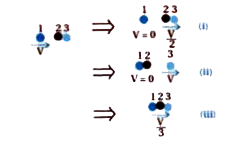
View SolutionThe bob A of a pendulum released from `30^(@)` to the vertical hits another bob B of the same mass at rest on a table as shown in figure . How high does the bob A rise after the collision ? Neglect the size of the bobs and assume the collision to be elastic .
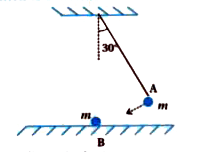
View SolutionThe bob of pendulum is released from a horizontal position . If the length of the pendulum is `1.5 m ` ,what is the speed with which the bob arrives at the speed with which the bob arrives at the lowermost point , given that it dissipated 5 % of its intial energy against air resistance ?
View SolutionA trolley of mass 30 kg carrying a sandbag of 25 kg is moving uniformly with a speed of 27 km/h on a frictionless track . After a while , sand starts leaking out of hole on the floor of the trolley of the rate of `0.05 " kg s"^(-1)` .What is the speeed of the trolley after the entire sand bad is empty ?
View SolutionA body of mass `0.5` kg travels in a straight line with velocity `v = ax^(3/2) "where " a=5m^(-1/2)s^(-1)` . What is the work done by the net force during its displacement from x = 0 to x = 2 m ?
View SolutionThe blades of a windmill sweep out a circle of area A . (a) If the wind flows at a velocity v perpendicular to the circle , what is the mass of the air passing through it in time t ? (b) What is the kinetic energy of the air ? (c ) Assume that the windmill converts 25 % of the wind's energy into electrical energy , and that A = 30 `m^(2)` , v = 36 km/h and the density of air is `1.2 m^(2)` v = 36 km/h and the density of air is `1.2` kg `m^(-3)` .What is the electrical power produced ?
View SolutionA person trying to lose weight (dieter ) lifts a 10 kg mass , one thousand times , to a height of 0.5 m each time .Assume that the potential energy lost each time she lowers the mass is dissipated . (a) How much work does she do against the gravitational force ? (b) Fat supplies `3.8 xx10^(7)` J of energy per kilogram which is converted to mechanical energy with a 20 % efficiency rate . How much fat will the dieter use up ?
View SolutionA family uses 8 kW of power.
Direct solar energy is incident on the horizontal surface at an average rate of 200 W per square meter. If 20% of this energy can be converted to useful electrical energy, how large an area is needed to supply 8 kW?
View SolutionA bullet of mass `0.012kg` and horizontal speed `70 ms^(-1)` strikes a block of wood of mass `0.4kg` and instantly comes to rest with respect to the block. The block is suspended from the ceiling by means of thin wires. Calculate the height to which the block rises. Also, estimate the amount of heat produced in the block.
View SolutionTwo inclined frictionless tracks , one gradual and the other steep meet at A from where two stones are allowed to slide down from rest , one on each track as shown in figure . Will the stones reach there with the same speed ? Explain . Given `theta_(1) = 30^(@) , theta_(2) = 60^(@) and h = 10 m ` What are the speeds and times taken by the two stones ?

View SolutionA 1 kg block situated on a rough incline is connected to a spring constant `100 Nm^(-1)` as shown in figure . The block is released from rest with the spring in the unstretched position . The block moves 10 cm down the incline before coming to rest . Find the coefficient of friction between the block and the incline .Assume that the spring has a negligible mass and the pulley is frictionless.
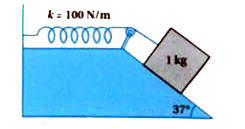
View SolutionA bolt of mass `0.3 kg` falls from the ceiling of an elevator moving down with an uniform speed of `7 ms^(-1)`. It hits the floor of the elevator (length of the elevator = 3m) and does not rebound. What is the heat produced by the impact? Would your answer be different if the elevator were stationary?
View SolutionA trolley of mass 200 kg moves with a uniform speed of 36 km/h on a frictionless track. A child of mass 20 kg runs on the trolley from one end to the other (10 m away) with a speed of `4 ms^(-1)` relative to the trolley in a direction opposite to the its motion, and jumps out of the trolley. What is the final speed of the trolley? How much has the trolley moved from the time the child begins to run?
View SolutionWhich of the following potential energy curves in figure cannot describe the elastic collision of two billiard balls ? Here r is the distance between centres of the balls .
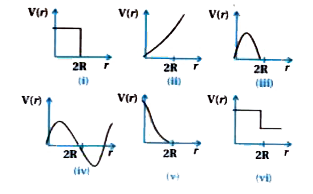
View SolutionConsider the decay of a free neutron at rest :
` n to p +e^(-)`
Show that the two body decay of this type must necessary give an electron of fixed energy and therefore cannot account distribution in the `beta - `decay of a neutron or a nucleous as shown in figure .

[ Note : The simple result of this exercise was one among the several arguments advanced by W . Pauli to perdict the existence of a third particle in the decay products of `beta - ` decay . This particle is known as neutrino spin `1/2 ` ( like `e^(-)` p or n ) but is neutral ad either massless or having an extremely small mass (compared to the mass of electron) and which interacts very weakly with matter . The correct decay process of neutron is : `n to p+e(-)+v)`
View Solution
SECTION - B Numericals (Numerical From Textual Exercise) questions and complete solutions for chapter WORK, ENERGY AND POWER of KUMAR PRAKASHAN KENDRA PHYSICS (GUJRATI ENGLISH) of Class 11
All Exercises from KUMAR PRAKASHAN Class 11 PHYSICS WORK, ENERGY AND POWER
- QUESTION PAPER (SECTION - A)
- QUESTION PAPER (SECTION - B)
- QUESTION PAPER (SECTION - C)
- QUESTION PAPER (SECTION - D)
- SECTION - A Questions - Answers (Introduction)
- SECTION - A Questions - Answers (Try Yourself (VSQs))
- SECTION - B Numericals (Numerical From .DARPAN. Based On Textbook)
- SECTION - B Numericals (Numerical From Textual Exercise)
- SECTION - B Numericals (Numerical From Textual Illustration)
- SECTION - C Objective Questions (VSQs)
- SECTION - D NCERT Exemplar Solutions (Long Answer Type Questions)
- SECTION - D NCERT Exemplar Solutions (Multiple Choice Questions)
- SECTION - D NCERT Exemplar Solutions (Short Answer Type Questions)
- SECTION - D NCERT Exemplar Solutions (Very Short Answer Type Questions)
- SECTION - E Multiple Choice Questions (MCQs)
- SECTION - F Questions From Module (Sample questions for preparation of competitive exams)